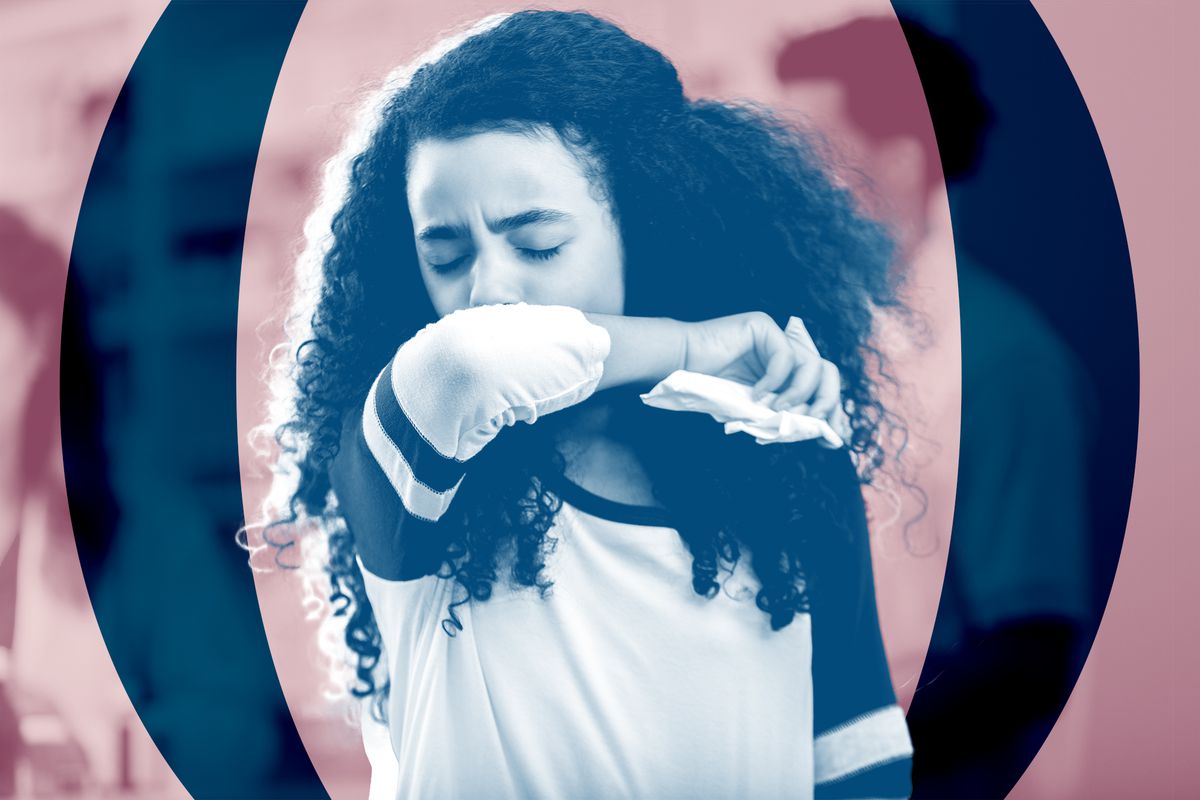Younger Children With COVID May Develop a Harsh, 'Barking' Cough, According to Doctors

As the Omicron variant of COVID-19 continues to surge throughout the country, pediatric cases of the virus are on the rise, with numbers "far exceeding the peak of past waves of the pandemic," according to the American Academy of Pediatrics (AAP). For the week ending January 6, the AAP reports that more than 580,000 cases of COVID-19 in children were reported—a 78% increase from the week prior.
Despite the rise in cases, experts maintain that children are still less likely than adults to become ill, and they may see milder illness when they do contract COVID-19, even the Omicron variant. It appears that children may also experience different symptoms than adults do: According to new reporting from NBC News, children under 5 years old who develop COVID-19 may show signs of croup, a common pediatric infection.
For those who've heard the characteristic harsh, barking cough of croup, the sound can be alarming—especially if it shows up in a child diagnosed with COVID-19. But, reassuringly, doctors say the symptom is seen often in childhood, and there could be a plausible reason why it's showing up more in COVID-positive kids. Here, experts help explain what you need to know about croup and COVID-19.
What is croup?
In children, upper respiratory infections sometimes result in a common pediatric condition called croup. According to Eric Zee, MD, a pediatric pulmonologist with Stanford Children's Health, croup—which is typically caused by respiratory viruses like parainfluenza and the common cold—is an infection that causes swelling and inflammation around a child's vocal cords and throat. This swelling can result in a unique, "barking" cough. "It can sound throaty and deep, like a seal barking," Dr. Zee tells Health. The US National Library of Medicine (MedlinePlus) adds that other flu-like symptoms, including fever and hoarseness.
Sheryl L. Henderson, MD, PhD, a pediatric infectious disease physician at UWHealth in Madison, WI, says that while croup can happen to anyone, including adults, it's far more common in kids—and even more common in children younger than 4 years old (children ages 6 months to 3 years old have the highest risk of developing croup, per MedlinePlus). "That's simply because young children's airways are that much smaller, so when they're swollen, their cough tends to whistle," says Dr. Henderson.
Croup can be alarming to hear, but it's not always dangerous. In fact, Dr. Henderson says it's often manageable at home. But when it's paired with another less-common croup symptom—stridor, or breathing that sounds like gasping—it can cause difficulty breathing. So if your child is sick, it's important to know what to look out for and when to call the doctor for help. Always seek immediate medical care if you think your child may be struggling to breathe.
What’s the link between Omicron and croup?
The reason why croup and another condition called bronchiolitis—an infection that causes the airways in your lungs (bronchioles) to become inflamed and narrow—have been seen in pediatric COVID-19 patients may have a lot to do with both children's anatomy and which part of the body the Omicron strain tends to affect the most.
While earlier strains of COVID-19 were more likely to settle deeper into the lungs and cause infections like pneumonia, the Omicron variant tends to stay in the upper airways, Tina Q. Tan, MD, a pediatric infectious disease physician and professor of pediatrics at Northwestern University Feinberg School of Medicine, tells Health. As a result, people (and children) with COVID-19 may experience more upper respiratory symptoms, like a runny or congested nose, cough, or sore throat, says Dr. Tan.
"When we think about the location Omicron is affecting in the body, it's more in the upper airway, so it might be more likely to cause inflammation around the vocal cords," adds Sheryl L. Henderson, MD, PhD, a pediatric infectious disease physician at the University of Wisconsin Hospitals and Clinics. In children, because their airways are smaller, the swelling that happens can cause their airways to constrict more than an adult's airways would. "Little kids' airways are so narrow that it takes far less inflammation to clog them," Buddy Creech, MD, MPH, a pediatric infectious disease expert and director of the Vanderbilt Vaccine Research Program at the Vanderbilt University Medical Center recently told NBC News.
What to do if your child develops a croup-like cough from COVID-19
First: If your child begins showing any symptoms of COVID-19, including the characteristic barking cough of croup, it's important to get them tested and isolated from other well family members if they receive a positive result. From there, it's about symptom management; the Children's Hospital of Philadelphia (CHOP) says that most cases of croup are mild and clear up with home remedies.
There's no specific over-the-counter medication used to treat croup, so remedies tend to focus more on household solutions. According to Dr. Tan, that can include turning on a cool mist humidifier or taking your child outdoors into cooler air—both of which can help reduce inflammation in the airway. Dr. Henderson adds that sitting in a steamed bathroom can help croup-like symptoms; if your child has a fever, you can also give them fever-reducing medications (acetaminophen or ibuprofen, as instructed by a doctor), and push fluids to make sure they don't become dehydrated. Keeping your child calm is important too: "When a child is upset and breathing hard they may have a more difficult time breathing," says Dr. Zee.
While croup doesn't usually turn severe, it's important to monitor your child's breathing; if at any point they begin noticeably working harder to breathe—this might look like using the muscles between their ribs or above their neck to inhale, known as retraction—it's time to seek help from a doctor. In more severe cases, CHOP says children are still usually discharged from the hospital after some medication (usually a dose of steroids to tamp down the inflammation) and a brief observation period, but some children may still need breathing treatments or breathing support in particularly severe cases.
As it has been throughout the pandemic, prevention is still key to the best health outcomes—that means vaccines, physical distancing, and proper handwashing to protect against COVID-19. But, since children under 5 years old are not currently eligible for a vaccine just yet, it's extra important for those around them to as safe as possible. "Right now, kids less than 5 [years old] are unable to be vaccinated, but having people around them that are fully vaccinated can really reduce the chance a young child will get COVID-19 or any manifestation, including croup," says Dr. Henderson.
The information in this story is accurate as of press time. However, as the situation surrounding COVID-19 continues to evolve, it's possible that some data have changed since publication. While Health is trying to keep our stories as up-to-date as possible, we also encourage readers to stay informed on news and recommendations for their own communities by using the CDC, WHO, and their local public health department as resources.
Source: Read Full Article

